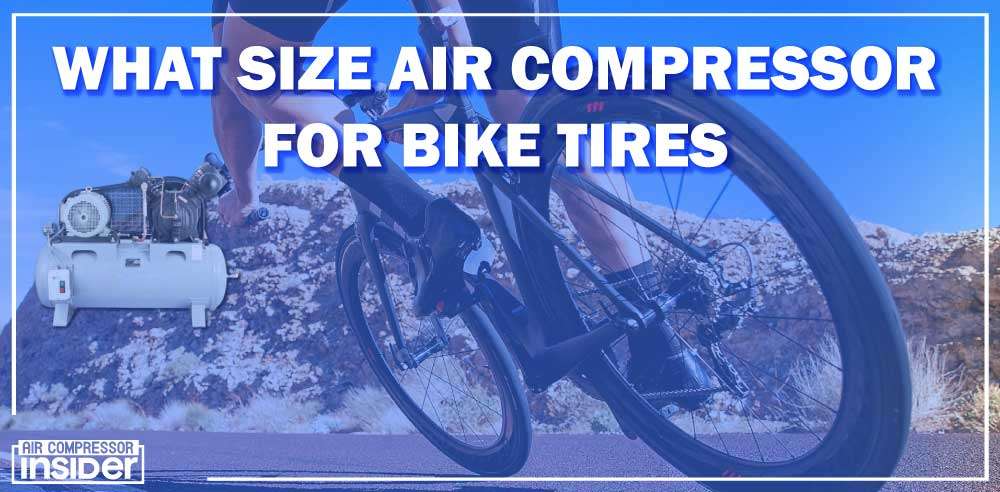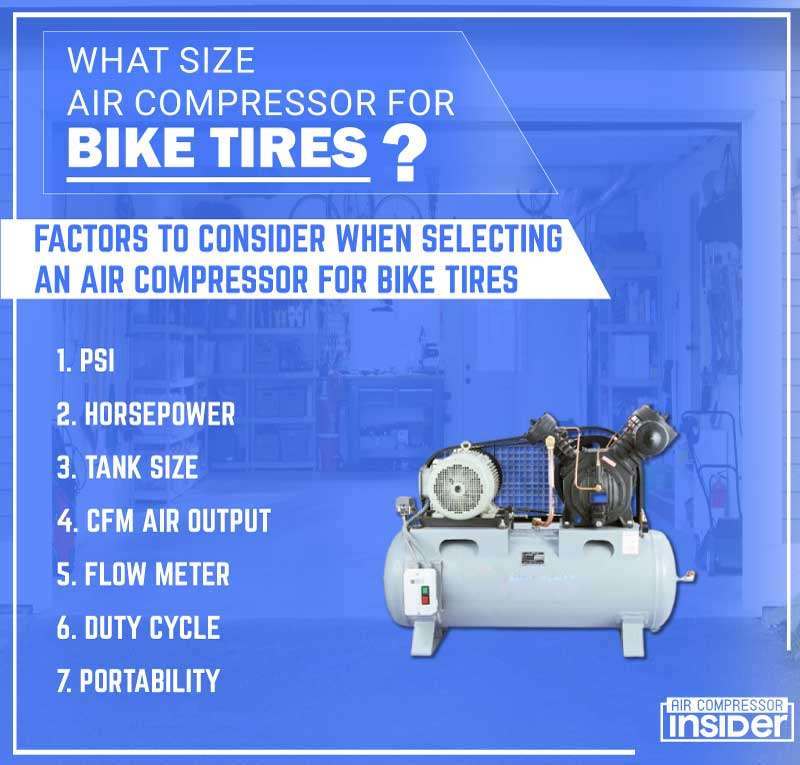Whether you’re an avid cyclist who rides for hours at a time or someone who simply wants to keep their bike tires inflated, knowing the right size air compressor is essential. You wouldn’t want too much pressure in your tires, because that can cause them to burst. On the other hand, having too little will lead to soft tires and excessive wear on your bike’s rims and spokes.
That’s why we’ve created this comprehensive guide on what size air compressor for bike tires is ideal for inflating easily. We’ll answer all of your questions about what type of air compressor to get, how much PSI it should provide, and more so that you can feel confident when selecting an air compressor for all your biking needs. So lets start!
What Size Air Compressor For Bike Tires

For bike tires, you’ll need an air compressor with a CFM rating of at least 2-3 and a PSI rating around 90-120. HP should be in the 1-2 range, and the tank size should be around 1-3 gallons or higher.

What Size Air Compressor For Bike Tires:
The size of your air compressor will depend on several factors, such as the type of bike you have and how many tires need to be inflated. Road bikes typically require higher pressure than mountain bikes, so a larger air compressor may be necessary for road biking. For mountain biking, a smaller compressor may suffice. You’ll also need to consider the size of your bike’s tires, as this will affect the amount of air needed to inflate them.
When it comes to PSI (pounds per square inch), there are general guidelines for each type of bike:
– Road bikes require around 90-120 PSI for optimal performance.
– Mountain bikes can range from 20-50 PSI, depending on the terrain and weight of the rider.
When selecting an air compressor for bike tires, it’s important to ensure that it has a regulator so you can adjust the pressure as needed. A good quality air compressor should also have a gauge so you can accurately measure the amount of air going into the tire.
7 Important Factors to Consider When Selecting an Air Compressor for Bike Tires:

When selecting the right size air compressor for your bike tires, there are a few key factors to consider. Here’s what you should look out for:
1. PSI Rate:
This is the amount of pressure that an air compressor can generate. The higher the PSI, the more pressure it can produce.
2. Horsepower:
This stands for Horsepower, which is the amount of power an air compressor has. The higher the horsepower, the better performance you can expect from your air compressor. For example, if you want an air compressor for truck tires , you will need higher HP, as compared to bicycle tires.
3. Tank Size:
This determines how much air can be stored in the tank before it needs to be refilled. Generally, larger tanks are better if you want an air compressor for car tires, as they allow for a greater volume of air to be stored and used at once.
4. CFM Air Output:
Cubic feet per minute (CFM) indicates how quickly air can be delivered from your air compressor. The higher the CFM rating, the more quickly you’ll be able to fill up a tire with air.
5. Flow Meter:
This measures and controls how much air is released from the compressor. A good quality flow meter will help you control the amount of air that goes into each tire, ensuring optimal inflation.
6. Duty Cycle:
This is how often your compressor can be used without having to take breaks. Longer duty cycles are better for continuous use, such as when inflating multiple tires in one go.
7. Portability:
If you need an air compressor for bike tires on the go, then portability is something to consider. Look for compressors that can easily be moved and transported so you can inflate your bike’s tires wherever you may be.
Factors in Detail:
Now let’s discuss these 7 factors one by one in detail.
PSI Requirement for Bike Tires:
The size of the air compressor you need will depend on the required pressure for your bike tires. Road bikes typically require higher pressure than mountain bikes, so a larger air compressor may be necessary for road biking. For mountain biking, a smaller compressor may suffice. You should check the manufacturer’s manual to get an exact PSI number for your bike tires. Generally, for road bikes, you should look for an air compressor with a PSI of 90-120 and for mountain bikes, between 20-50. For larger RV tires, you will need a larger air compressor with higher PSI rating.
CFM Requirement for Bike Tires:
The CFM rating of an air compressor indicates how quickly it can deliver the stored air from its tank. With a higher CFM rating, you’ll be able to fill up your tire with air much faster than with a lower rating. Look for an air compressor with a CFM rating of at least 2 or 3 for optimal performance when inflating bike tires.
Horsepower Requirement for Bike Tires:
The horsepower of an air compressor indicates how powerful it is. The higher the horsepower, the more powerful the performance of your air compressor. You should always look for an air compressor with a higher horsepower rating if you want the best performance, especially when inflating bike tires.
Tank Size Requirement for Bike Tires:
The tank size of an air compressor determines how much air it can store before having to be refilled. Generally, larger tanks will provide more air volume, which is ideal if you’re inflating multiple tires in one go. For inflating bike tires, a tank size of 1-3 gallons should suffice.
Flow Meter Requirement for Bike Tires:
A flow meter helps to control the amount of air that is released from an air compressor. A good quality flow meter allows you to accurately measure how much air is going into each tire, allowing for a precise inflation.
Duty Cycle Requirement for Bike Tires:
The duty cycle of an air compressor indicates how often it can be used without having to take breaks. Longer duty cycles are ideal if you’re inflating multiple tires in one go, as this will prevent the need for waiting for the compressor to cool down after every use. Look for an air compressor with a duty cycle rating of at least 50-60% or higher when inflating bike tires.
Portability Requirement for Bike Tires:
If you’re looking for an air compressor that can be easily transported, then portability is something to consider. Compressors with wheels are ideal if you want to move the unit around quickly and easily. You may also want to look for compressors that are lightweight and compact in size, so they can fit into tight spaces or small bags when on the go.
Why Do I Need An Air Compressor For Bike Tires?
An air compressor is an essential tool for bike owners as it allows you to easily and quickly inflate your tires. It also helps to ensure that your tires are at the correct pressure so they can perform optimally. Without a good quality air compressor, inflating your bike’s tires manually would be much more difficult and time-consuming.
Frequently Asked Questions
Question #1
What size air compressor do I need for bike tires?
The size of the air compressor you need will depend on the required pressure for your bike tires. Generally, for road bikes, you should look for an air compressor with a PSI of 90-120 and for mountain bikes, between 20-50.
Question #2
What horsepower (HP) do I need for my air compressor?
The higher the horsepower rating of your air compressor, the more powerful its performance. You should look for an air compressor with a higher horsepower rating if you want the best performance when inflating bike tires.
Question #3
What tank size do I need for my air compressor?
A larger tank will provide more air volume, which is ideal if you’re inflating multiple tires in one go. For inflating bike tires, a tank size of 1-3 gallons should suffice.
Question #4
What cubic feet per minute (CFM) rating do I need for my air compressor?
You should look for an air compressor with a CFM rating of at least 2 or 3 for optimal performance when inflating bike tires.
Question #5
Do I need a flow meter for my air compressor?
A flow meter helps to control the amount of air that is released from an air compressor and allows you to accurately measure how much air is going into each tire.
Question #6
What duty cycle rating do I need for my air compressor?
When inflating bike tires, look for an air compressor with a duty cycle rating of at least 50-60% or higher.
Question #7
Is portability important when choosing an air compressor?
If you want to easily transport your air compressor, portability should be taken into consideration. Look for compressors with wheels and lightweight and compact designs.
Question #8
Why do I need an air compressor for bike tires?
An air compressor is essential for bike owners as it allows you to easily and quickly inflate your tires, ensuring that they are at the correct pressure for optimal performance.
Question #9
What safety features should my air compressor have?
Your air compressor should have safety features such as automatic shut-off, a thermal overload protector and an on/off switch to prevent any accidents occurring while using the unit.
Question #10
How often should I check my bike tire pressure?
It’s recommended that you check your bike tire pressure at least once a month or more if frequently riding in different terrains, such as off-road. Making sure your tires are at the correct pressure will ensure optimal performance and safety when cycling.
Conclusion:
With the right air compressor, inflating bike tires is no longer a difficult task. When choosing an air compressor for your bike tires, there are several factors to consider such as size, power, tank capacity and duty cycle rating. Additionally, make sure to look for compressors with portability features such as wheels and lightweight designs. Finally, it’s important to check your bike tire pressure regularly for optimal performance and safety.
